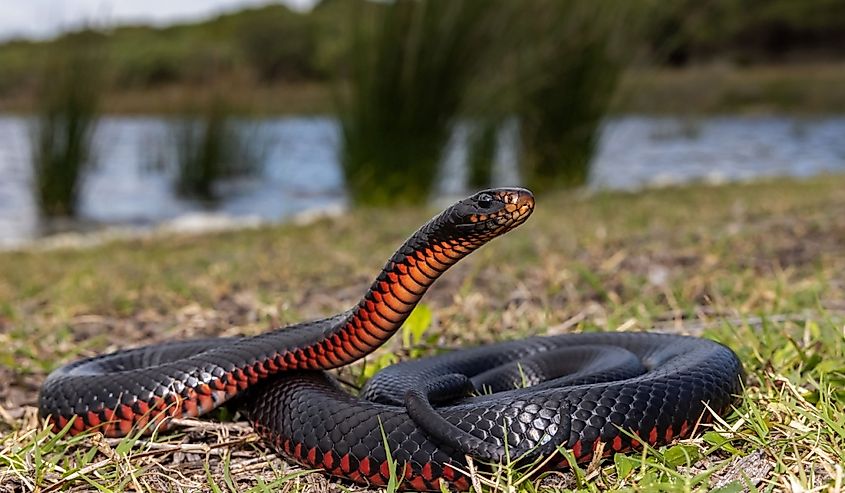
The Venomous Snakes Of Australia
Australia has a global reputation for its intriguing yet daunting biodiversity, which includes many venomous snakes that attract wildlife explorers. Aside from fulfilling essential functions within their environments, these snakes are commonly avoided due to their strong venom and accidental run-ins with tourists and locals. They help maintain the balance of their natural homes by influencing rodents and other pest populations.
However, their presence in both rural and urban areas can cause issues; therefore, education and awareness are necessary. Australia has six common venomous snakes with specific characteristics and habitats and recommended guidelines for safe coexistence that everyone must know.
Eastern Brown Snake

The Eastern Brown Snake, one of Australia's most encountered venomous snakes, is responsible for the majority of snakebite fatalities in the country since it is in close proximity to human settlements. This snake is slim-bodied with varying shades of brown, and it thrives in open grasslands, agricultural areas, and forests.
Known for its agility and defensive nature when threatened, this snake delivers a potent venom that affects both the circulatory and nervous systems. To reduce the risk of encounters, it is advisable to keep gardens and outdoor areas free of debris and other hiding spots.
Red-Bellied Black Snake

The Red-Bellied Black Snake is a vibrantly colored species found along the eastern coast of Australia. It has a glossy black body with vibrant red or pink on its stomach, making it easy to identify. Typically, comfort is found in wetlands, swamps, and streams; they can also be seen in woodlands and grasslands. Its venom is not recorded to be as potent as some other venomous snakes, yet it can pose worrisome effects to humans, inflicting symptoms like pain, swelling, and nausea.
Though its venom contains mycotoxins and coagulants, it is rarely fatal with immediate care. The notorious snake is normally shy and non-aggressive, often slithering away when confronted with people, but it should still be feared, especially near water sources.
Inland Taipan

The Inland Taipan, also known as the Fierce Snake, is renowned for having the most dangerous venom of any reptile. Its venom is six times more powerful than that of the Eastern Brown Snake, the second most venomous land snake.
This reclusive snake, found in the arid regions of inland Eastern Australia, primarily feasts on rodents and delivers lethal venom with each strike. Despite their deadly bites, they are generally docile, and human bites are rare, mainly occurring with certified handlers. Bites are often deadly without prompt anti-venom treatment, and even with treatment, they can cause severe, lasting damage.
Mainland Tiger Snake

Mainland tiger snakes are found along the southeastern coast of Australia, including New South Wales, Victoria, Tasmania, and the far corner of South Australia. They inhabit highly populated areas on the east coast, such as Melbourne, and are commonly found on farms and suburban outskirts. They are drawn to hunt mice at night, which often leads to accidental encounters with humans, who may unknowingly step on them.
Tiger snakes are responsible for the second-highest number of bites in Australia. If untreated, their bites can be fatal, with symptoms beginning as pain in the feet and neck, followed by tingling, numbness, and sweating. These are then followed by breathing difficulties, paralysis, and potentially renal failure.
Common or Southern Death Adder

The death adder is found across most of eastern Australia, the southern part of South Australia, and Western Australia. Unlike other snakes that flee from noisy humans, the death adder remains motionless and concealed, waiting for an unsuspecting bushwalker to come too close.
This snake uses a worm-like lure at the end of its tail to attract prey and is known as the world's fastest-striking snake, biting in just over a tenth of a second. Unlike many snakes with more complex venoms, the death adder's venom is purely neurotoxic, causing death through paralysis and respiratory failure within as little as six hours.
Coastal Taipan

The coastal taipan, common along Australia’s eastern coast, is a formidable predator that thrives in sugar cane fields and other agricultural areas. The coastal taipan primarily preys on mammals like mice, rats, and birds.
Though it does not actively seek confrontation, it can launch itself at a target and deliver multiple rapid bites when startled. Its scarily long fangs are among the longest of any Australian snake and can penetrate boots and thick socks. Prompt medical attention is critical, as bites were almost always fatal before the development of an effective antivenin in the late 1950s, with deaths occurring in as little as 60 minutes.
This thorough breakdown of Australia's venomous snakes emphasizes the significance of appreciating these fearsome reptiles, coupled with their varied habitats and tendencies. These snakes represent more than simply the untamed beauty of Australia; they also remind tourists and residents of the importance of protecting the wildlife of the land down under. Recognizing the ecological roles of these snakes is crucial for coexistence and conservation efforts in this biodiverse region and the threats they come with, whether they are discovered in rural or urban areas intentionally or by mistake.











